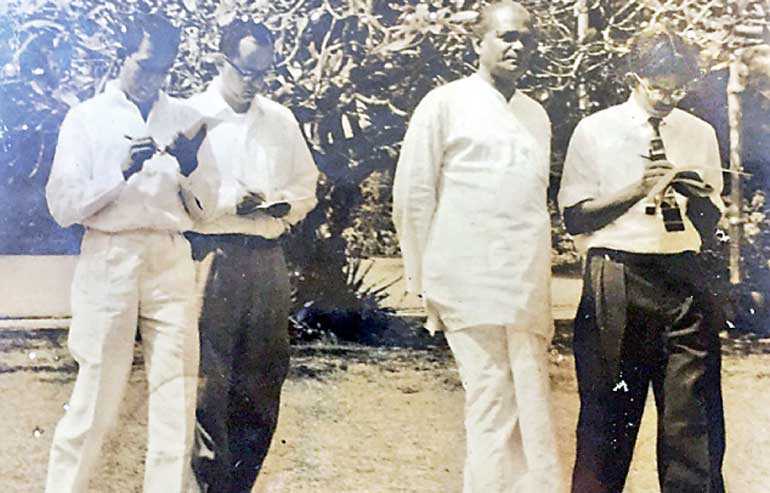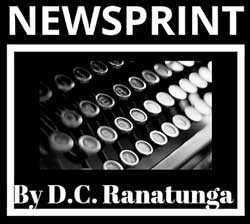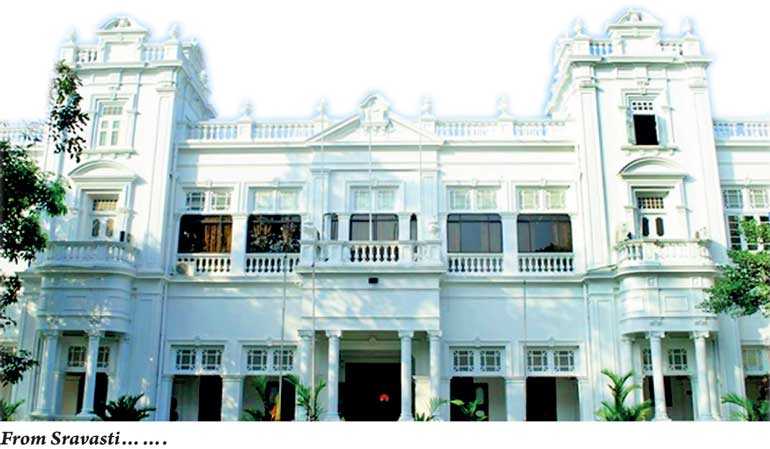Monday Mar 17, 2025
Monday Mar 17, 2025
Saturday, 23 March 2019 00:00 - - {{hitsCtrl.values.hits}}

From Sravasti…….

…to Temple Trees
Sunday 27 September 1959. For those in the news desk it was going to be a busier day than other Sundays when we took it rather easy. (Sunday was a working day for those in the morning daily papers.) The Sunday papers carried the news of the Prime Minister’s death and the swearing in of Senior Minister Wijayananda Dahanayake as the Prime Minister. We had to follow up on the funeral arrangements and work on the new Prime Minister’s plans.
It was ‘luck by chance’ as we used to say in colloquial terms, for Education Minister Dahanayake. Senior Minister C.P. de Silva had been rushed to London for treatment when he suddenly fell ill at the Cabinet meeting the previous month. Since Prime Minister Bandaranaike was due to attend the UN General Assembly he had informed the Governor-General Sir Oliver Goonetilleke that during his absence Minister Dahanayake would act for him. The letter had been delivered on Friday by PM’s Secretary Bradman Weerakoon to GG’s Secretary N.W. Athukorale. Sir Oliver was thus covered by the letter when he appointed Dahanayake as PM on Saturday.
On Sunday we had to meet the Prime Minister. Daily News News Editor Gerry Delilkhan had got an appointment and both of us went to Temple Trees, the PM’s official residence which  was used by Bandaranaike only for official functions. Bachelor Dahanayake had moved from Sravasti, the MP’s hostel where he stayed throughout his career as MP, to Temple Trees on Saturday. In fact, he had found the main bedroom (as well as other rooms) too large and had got the Government Stores Head, who was present to show him round, to get carpenters and make the room smaller sufficient to have a single bed and a wardrobe. The job was done without any delay.
was used by Bandaranaike only for official functions. Bachelor Dahanayake had moved from Sravasti, the MP’s hostel where he stayed throughout his career as MP, to Temple Trees on Saturday. In fact, he had found the main bedroom (as well as other rooms) too large and had got the Government Stores Head, who was present to show him round, to get carpenters and make the room smaller sufficient to have a single bed and a wardrobe. The job was done without any delay.
As we arrived at Temple Trees he was in his usual white national dress ready to meet us. He greeted us and said that the BBC correspondent and a photographer were also coming. When he saw them and found the photographer was having a cine camera with him (they were pre-video days) he told us, “Gentlemen, let us move out to the garden so that he can photograph as I walk along chatting to the three of you.” So we interviewed him out in the garden at the entrance to Temple Trees.
He told us that the immediate job was to attend to the funeral arrangements in consultation with Mrs. Bandaranaike and family members. Future plans would be discussed with the Cabinet. Being the simple, unassuming individual from the days he got elected to the State Council from the remote Bibile seat in 1940 though far away from Galle, his birthplace, it was evident that he would to be easily approachable. As always, he continued to be a friend of the media irrespective of being the Prime Minister and Minister of Defence, External Affairs and Education.
In his book ‘Rendering unto Caesar,’ Bradman Weerakoon describes Dahanayka: “If S.W.R.D. Bandaranaike had ushered in the age of the common man, W. Dahanayake who followed him as Prime Minister on his untimely death, was surely the common man himself. Or so he looked at first glance. Dressed always in the white national dress – not necessarily always spotless or immaculately cut like Mr. Bandaranaike’s – with a rustic homespun touch about him, a non-smoker and teetotaller at the time I first met him, Dahanayake could easily have fitted the bill. He chatted easily in colloquial Sinhala with a choice of words which bespoke his south Ceylon origin, enjoyed chewing betel after a meal and could squirt out the detritus into a spittoon, or far out into the yard, with the best of them. Along with his disarmingly simple mannerisms and modest ways, he had, in his rather long political life, acquired a reputation for honesty, outspokenness, unpredictability and for being very much on the side of the underdog.”

Discover Kapruka, the leading online shopping platform in Sri Lanka, where you can conveniently send Gifts and Flowers to your loved ones for any event including Valentine ’s Day. Explore a wide range of popular Shopping Categories on Kapruka, including Toys, Groceries, Electronics, Birthday Cakes, Fruits, Chocolates, Flower Bouquets, Clothing, Watches, Lingerie, Gift Sets and Jewellery. Also if you’re interested in selling with Kapruka, Partner Central by Kapruka is the best solution to start with. Moreover, through Kapruka Global Shop, you can also enjoy the convenience of purchasing products from renowned platforms like Amazon and eBay and have them delivered to Sri Lanka.
Discover Kapruka, the leading online shopping platform in Sri Lanka, where you can conveniently send Gifts and Flowers to your loved ones for any event including Valentine ’s Day. Explore a wide range of popular Shopping Categories on Kapruka, including Toys, Groceries, Electronics, Birthday Cakes, Fruits, Chocolates, Flower Bouquets, Clothing, Watches, Lingerie, Gift Sets and Jewellery. Also if you’re interested in selling with Kapruka, Partner Central by Kapruka is the best solution to start with. Moreover, through Kapruka Global Shop, you can also enjoy the convenience of purchasing products from renowned platforms like Amazon and eBay and have them delivered to Sri Lanka.